A new program is changing how some palliative care patients will receive care after calling 911.
The one-year pilot project will help protect hospital capacity while Ontario responds to the third wave of COVID-19, according to the May 6 announcement.
The northeastern Ontario pilot project is for emergency medical services in the Cochrane District, the District of Nipissing, the District of Manitoulin-Sudbury, the City of Greater Sudbury, Algoma District, Parry Sound, the District of Timiskaming, the Weeneebayko Area Health Authority, and the District of Sault Ste. Marie.
Right now, paramedics bring 911 patients to hospital emergency departments even if other appropriate care treatments are available.
"Under the innovative patient care model pilot, eligible palliative care patients who call 911 will have the option to receive treatment at home. Paramedics specially trained in symptom management, including pain or shortness of breath, agitation, terminal congested breathing, nausea and vomiting will have the ability to treat patients at home should they choose," reads the news release.
"Paramedics then directly coordinate with the patient’s primary palliative care team or with a local hospice where the patient is registered, to ensure they are able to receive longer-term supports and wrap-around care. The patient will remain in ultimate control of the care they receive and can at any time request to be taken to the emergency department."
After the first year, the program will be evaluated to assess the outcomes and identify where adjustments may be needed.
"In rural and Northern Ontario paramedics have long been invaluable resources in providing wrap-around services across our vast geography,” said Parry Sound-Muskoka MPP Norm Miller.
He said the announcement will allow paramedics to empower patients by putting them in control of care decisions.
"This is going to have a huge impact on the patient’s experience and will allow them to receive care where they are most comfortable," said Miller.



